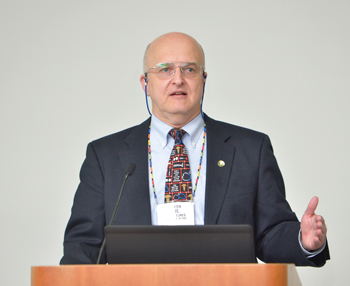Tiny ticks, big myths: Lyme disease pearls
Six easy pearls can help with the growing and controversial elements of treating Lyme disease.
Any clinical confusion about Lyme disease may have been quashed during one presentation at Internal Medicine Meeting 2017.
Infectious diseases subspecialist Stephen J. Gluckman, MD, FACP, unpacked a host of pearls about the disease and the ticks that carry it during his broader presentation on vector-borne infections. “I do this with great trepidation because it generates all sorts of angst and debate, and I don't debate with my patients about this because the camps tend to be so polar that there's not a lot of ground to discuss,” he said. “I just give them my opinion, and I try to tell them where my opinion comes from.”

The Lyme disease bacterium, Borrelia burgdorferi, is transmitted by very small ticks belonging to the Ixodes genus (aka deer ticks or blacklegged ticks), and most cases of the infection are spread to humans by nymphs and adult females, said Dr. Gluckman. “No tick bites hurt, by the way, so it's not as if when a person gets bitten, they know it,” he said.
Dr. Gluckman, a professor of medicine at the Hospital of the University of Pennsylvania in Philadelphia, offered the following tips for diagnosing and treating Lyme disease.
Pearl No. 1: Erythema migrans is a key sign of Lyme.
In general, a patient doesn't need a history of a tick bite for one to consider a tick-related illness, said Dr. Gluckman. “You just need a history that a person had the potential to get a tick bite; they were in a region where there were ticks,” he said. The opposite is also true: A patient might note a tick bite, but it's not necessarily clinically relevant, he noted.
The “big center” of Lyme disease is New England and is slowly moving south because the vector is moving south, he said. “But there is also a sizable region of Lyme disease just north of Chicago and up into Wisconsin, and a little bit on the West Coast,” Dr. Gluckman said.
If a patient's history is consistent with possible tick exposure, any large red patch on the body with no other explanation should be considered erythema migrans and managed as if it's Lyme disease, he noted. “Target” lesions only appear about a third of the time, and in about 5% of cases, the center of the lesion will vesiculate and occasionally even necrose, said Dr. Gluckman.
Erythema migrans is never a medical emergency, he said, so if one is unsure about a small red patch, it can be watched for a few days prior to treatment. “If it's slowly growing, it's erythema migrans unless you have some other reason to think it's something else,” Dr. Gluckman said. “If it disappears, it wasn't.”
After removing a tick, it's not unusual to notice a red area where it was attached, but this is no cause for concern, he said. “It may get to be the size of a quarter or something like that, and you can pretty much tell somebody over the phone if they give you this history, then it is not Lyme,” he said. This type of spot occurs and expands over hours and disappears after a couple of days, whereas erythema migrans is large (more than 5 cm) and usually appears and expands after about seven to 10 days before disappearing over weeks, Dr. Gluckman said.
Pearl No. 2: There is no diagnostic test for Lyme disease.
Much of the confusion about Lyme has arisen from misunderstandings about serological testing for the disease, he said. “There is no test for Lyme disease. There is a test (and I explain this to patients) for antibodies to B. burgdorferi, but that doesn't necessarily mean active disease,” said Dr. Gluckman. There are many unapproved tests for Lyme, but “We shouldn't be managing patients on the basis of unapproved, unstandardized tests for whatever the disease is,” he said.
A true positive test is a positive screening test (enzyme-linked immunosorbent assay or immunofluorescence assay) and a positive confirmatory test (western blot), yet many patients are told they have the disease with a positive screening test and negative confirmatory test, Dr. Gluckman said. “I don't think any one of us would tell a patient they had syphilis if they had a positive screening test and a negative confirmatory test,” he said.
A common error among clinicians is treating to eliminate Lyme antibodies. “In fact, a strong way to state this is once you know a patient has a true positive test, there's no indication to ever do it again. … Once it's positive, it's positive. It's an antibody,” said Dr. Gluckman.
Although the test for Lyme can't prove active disease, it's a great test for ruling it out, said Dr. Gluckman. False-negative tests are exceedingly rare, other than in the first week or two before antibodies are created, he noted. And if patients present with the right clinical symptoms, testing isn't even necessary. “If somebody comes in with an erythema migrans rash, I don't do testing. … I'm going to treat them, positive or negative test; there's no reason to do a test on them,” said Dr. Gluckman.
Pearl No. 3: Active Lyme disease infection is easy to treat.
Lyme disease infection is “a very easy bug to treat—if you have it. … It can certainly give the appearance it's a hard disease to treat [if] it's the wrong diagnosis,” Dr. Gluckman said, adding that there is rarely a reason to retreat a patient.
The basic treatment is oral doxycycline (100 mg twice a day) or amoxicillin (500 mg three times a day) for 10 to 21 days. IV treatment with ceftriaxone or cefotaxime is rarely needed, he said. There is no advantage to using other antibiotics, such as azithromycin, clarithromycin, and cefixime, said Dr. Gluckman.
“[In] a study looking at azithromycin and amoxicillin, amoxicillin was a better drug than azithromycin, for instance,” he said. “There's no good reason to use these other drugs.” People don't develop perfect immunity and can get Lyme disease again, but not because the initial treatment failed, he added.
Pearl No. 4: There is no indication to give antibiotics to patients with post-Lyme disease syndrome.
Although Lyme disease presents fairly similarly throughout the world, Dr. Gluckman noted some regional differences. “Most notable is they don't seem to see any of this post-Lyme syndrome in Europe,” he said. The syndrome is a collection of symptoms (e.g., chronic fatigue, chronic diffuse aching, “low-grade” fevers) but is not a manifestation of active infection with B. burgdorferi, said Dr. Gluckman. “I do the best I can to convince patients of this, that I don't agree with the diagnosis that perhaps others have given them,” he said. “But it doesn't mean I don't feel their symptoms are not valid and real.”
Most important, several controlled trials have shown that further antibiotic treatment doesn't relieve this syndrome any more than placebo, Dr. Gluckman noted. “So whether you argue about active infection or not, there should be no argument about further treatment,” he said. Oftentimes, Dr. Gluckman said, these symptoms are best explained by chronic fatigue syndrome or fibromyalgia. “Active Lyme disease is generally easy to diagnose, generally easy to treat, but diseases misdiagnosed as Lyme disease are generally difficult to treat,” he said.
Pearl No. 5: Tick removal should not be a complex procedure.
There are a couple of points to remember when patients ask how to remove these tiny ticks, and Dr. Gluckman's advice is simple: Don't make a project out of it. Lubricants like petroleum jelly only grease up the tick and make it more difficult to remove, and burning the ticks doesn't make them scream and let go, he said. “The patient may scream, but the tick doesn't.”
So what's one to do? Fingers are too big for the job (unless one has suitable fingernails), so find a tool that can firmly grab the tick, Dr. Gluckman said. At home, use a hemostat or forceps to grasp the embedded tick as close to the skin as possible and firmly pull perpendicularly, he said. Away from home, a Swiss Army knife with tweezers would work, and so would scraping the tick out with a sharp-edged stone or a seashell, Dr. Gluckman added. “And don't get excited if the head comes off or not—it's meaningless,” he noted. “It'll just get rejected by the body in a day or two, so don't make an additional hole in the patient trying to dig out the head.”
Pearl No. 6: Prophylactic antibiotics are sometimes indicated after a tick bite.
Under certain circumstances, a patient may be a candidate for a one-time prophylactic dose of doxycycline (200 mg) in areas where Lyme disease is reasonably common, Dr. Gluckman said. To determine this, he said there are three key questions to answer: What type of tick was this? Was it engorged or attached? How long was it attached for?
First, Lyme is the only tick-borne disease with a potential recommendation for antimicrobial prophylaxis, so the offender must have been an Ixodes tick, he said. Second, the tick must have been engorged or attached in order to transmit the bug. Finally, it takes at least 36 hours of feeding for the bacterium to get transmitted, so there's no indication for antibiotics if the tick was feeding for less than that, Dr. Gluckman said. “For most patients, prophylactic antibiotics are not indicated, but occasionally they are,” he said, and prophylaxis must be started within 72 hours of tick removal.





